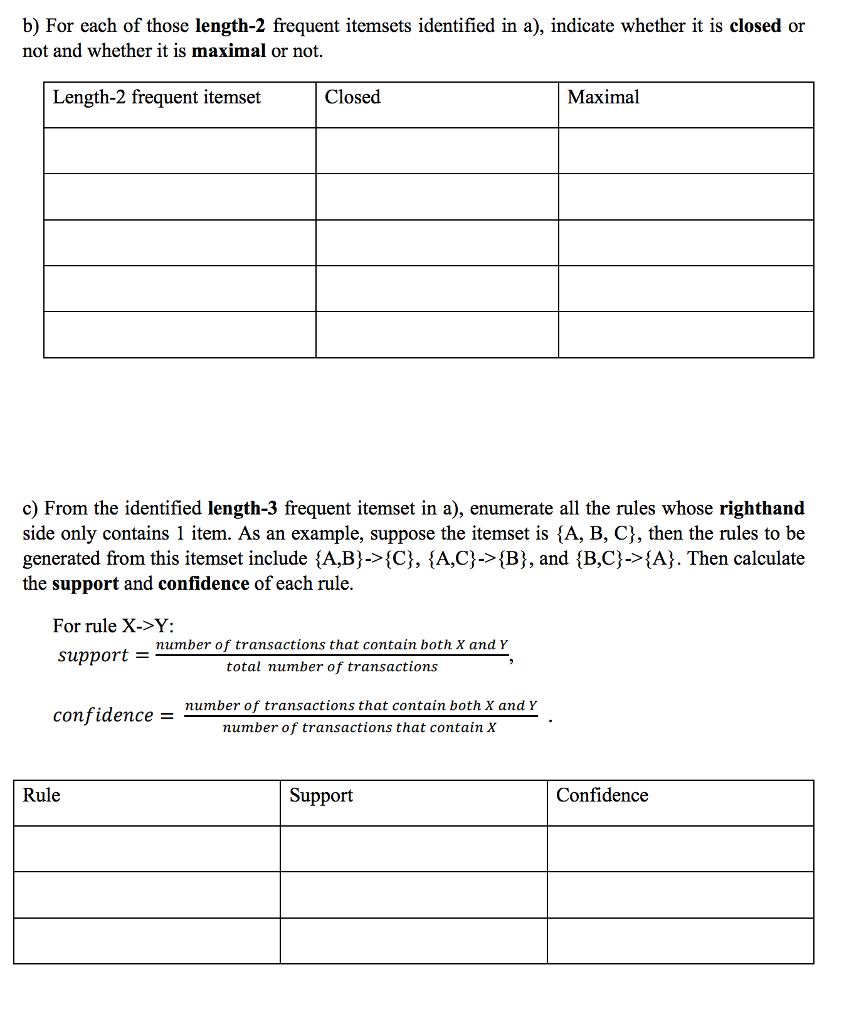Question
Suppose a trip planning service analyzes tourists trajectories and identifies which set of cities they always visit together during one trip. The table below shows


Suppose a trip planning service analyzes tourists trajectories and identifies which set of cities they always visit together during one trip. The table below shows the trajectories of some tourists in USA. The minimum support count is 2.
a)Please circle all the frequent itemsets below: {New York}, {Boston}, {Buffalo}, {Philadelphia}, {LA}, {Seattle}, {Orlando}, {Miami}, {Chicago}, {San Francisco} {New York, Boston}, {New York, Buffalo}, {New York, Philadelphia}, {Boston, Buffalo}, {Boston, Philadelphia}, {Buffalo, Philadelphia}, {New York, LA}, {New York, Seattle}, {LA, Seattle}, {Seattle, San Francisco}, {San Francisco, LA}, {Boston, Orlando}, {Boston, Miami}, {Orlando, Miami}, {Chicago, New York}, {Chicago, Boston}, {Chicago, Orlando}, {New York, Orlando} {New York, LA, Seattle}, {Seattle, San Francisco, LA}, {Boston, Orlando, Miami}, {New York, Buffalo, Boston}, {Boston, Buffalo, Philadelphia}, {New York, Buffalo, Philadelphia}, {New York, Boston, Philadelphia}, {New York, Boston, Orlando}, {Chicago, Boston, Orlando}, {Chicago, New York, Orlando},{Chicago, New York, Boston} {New York, Boston, Buffalo, Philadelphia}, {Chicago, New York, Boston, Orlando}
b) For each of those length-2 frequent itemsets identified in a), indicate whether it is closed or not and whether it is maximal or not.
c) From the identified length-3 frequent itemset in a), enumerate all the rules whose righthand side only contains 1 item. As an example, suppose the itemset is {A, B, C}, then the rules to be generated from this itemset include {A,B}->{C}, {A,C}->{B}, and {B,C}->{A}. Then calculate the support and confidence of each rule.
The problem is about data mining Association Analysis
Suppose a trip planning service analyzes tourists' trajectories and identifies which set of cities they always visit together during one trip. The table below shows the trajectories of some tourists in USA. The minimum support count is 2. Trajectory ID Places visited 1 New York, Boston, Buffalo, Philadelphia 2 New York, LA, Seattle 3 Seattle, San Francisco, LA 4 Boston, Orlando, Miami New York, Buffalo, Boston 6 Chicago, New York, Boston, Orlando a) Please circle all the frequent itemsets below: {New York), (Boston, {Buffalo), {Philadelphia), {LA), (Seattle), {Orlandoj, {Miami), {Chicago), {San Franciscoj {New York, Boston), {New York, Buffalo), {New York, Philadelphia), {Boston, Buffalo), {Boston, Philadelphia), {Buffalo, Philadelphia), {New York, LA), {New York, Seattle), {LA, Seattle), {Seattle, San Franciscoj, {San Francisco, LA), {Boston, Orlando), {Boston, Miami}, Orlando, Miami), {Chicago, New York), {Chicago, Boston), {Chicago, Orlando), {New York, Orlando) {New York, LA, Seattle), {Seattle, San Francisco, LA), (Boston, Orlando, Miami), {New York, Buffalo, Boston), {Boston, Buffalo, Philadelphia), New York, Buffalo, Philadelphia), {New York, Boston, Philadelphia), {New York, Boston, Orlandoj, {Chicago, Boston, Orlando), {Chicago, New York, Orlando),{Chicago, New York, Boston) {New York, Boston, Buffalo, Philadelphia), {Chicago, New York, Boston, Orlando) Suppose a trip planning service analyzes tourists' trajectories and identifies which set of cities they always visit together during one trip. The table below shows the trajectories of some tourists in USA. The minimum support count is 2. Trajectory ID Places visited 1 New York, Boston, Buffalo, Philadelphia 2 New York, LA, Seattle 3 Seattle, San Francisco, LA 4 Boston, Orlando, Miami New York, Buffalo, Boston 6 Chicago, New York, Boston, Orlando a) Please circle all the frequent itemsets below: {New York), (Boston, {Buffalo), {Philadelphia), {LA), (Seattle), {Orlandoj, {Miami), {Chicago), {San Franciscoj {New York, Boston), {New York, Buffalo), {New York, Philadelphia), {Boston, Buffalo), {Boston, Philadelphia), {Buffalo, Philadelphia), {New York, LA), {New York, Seattle), {LA, Seattle), {Seattle, San Franciscoj, {San Francisco, LA), {Boston, Orlando), {Boston, Miami}, Orlando, Miami), {Chicago, New York), {Chicago, Boston), {Chicago, Orlando), {New York, Orlando) {New York, LA, Seattle), {Seattle, San Francisco, LA), (Boston, Orlando, Miami), {New York, Buffalo, Boston), {Boston, Buffalo, Philadelphia), New York, Buffalo, Philadelphia), {New York, Boston, Philadelphia), {New York, Boston, Orlandoj, {Chicago, Boston, Orlando), {Chicago, New York, Orlando),{Chicago, New York, Boston) {New York, Boston, Buffalo, Philadelphia), {Chicago, New York, Boston, Orlando)Step by Step Solution
There are 3 Steps involved in it
Step: 1

Get Instant Access to Expert-Tailored Solutions
See step-by-step solutions with expert insights and AI powered tools for academic success
Step: 2

Step: 3

Ace Your Homework with AI
Get the answers you need in no time with our AI-driven, step-by-step assistance
Get Started


